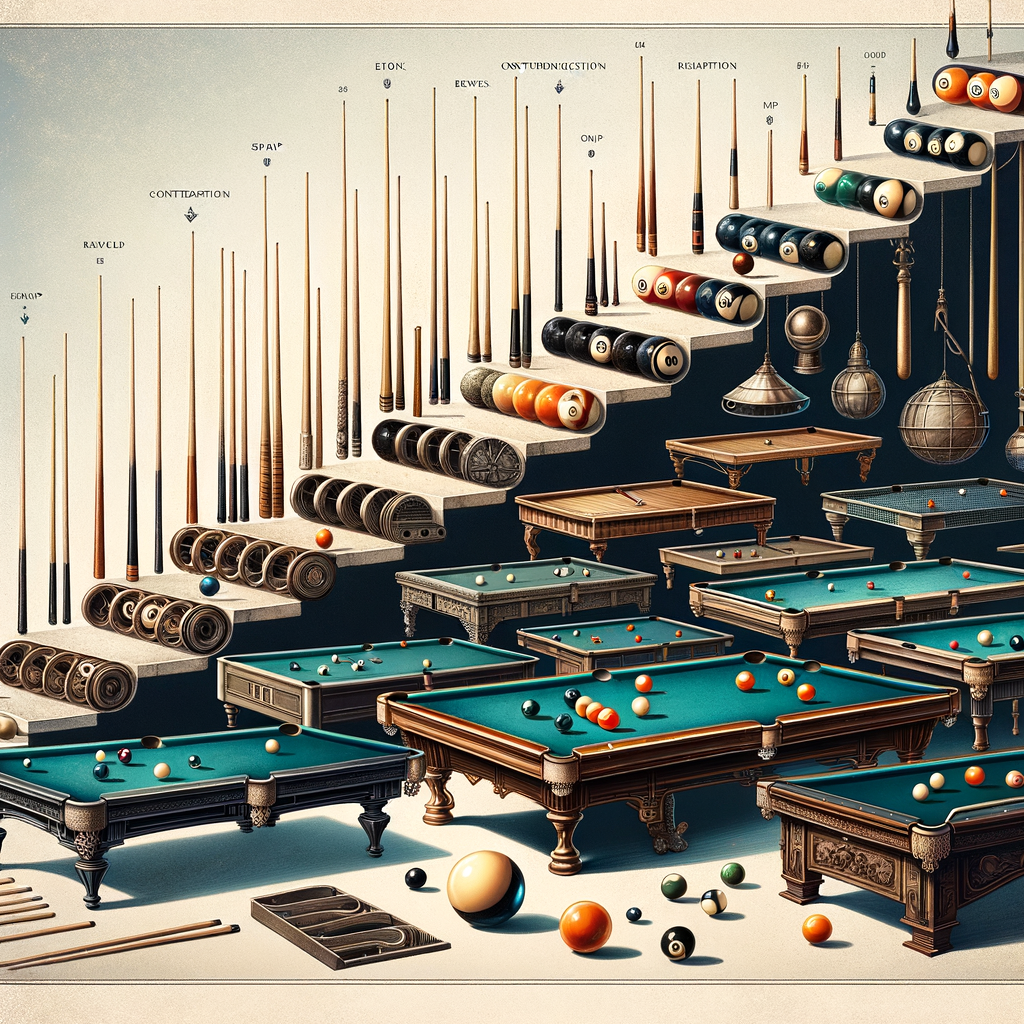
Introduction to Billiards History
Billiards, a game that has entertained people for centuries, has a rich and fascinating history. This article will take you on a journey through time, exploring the origins of the game and how it has evolved over the centuries.
-
- Origins of the Game
The game of billiards traces its roots back to the 15th century in Northern Europe. It began as an outdoor lawn game similar to croquet, played by the nobility. The game was eventually moved indoors, and a wooden table with green cloth was used to simulate the grassy playing field. The term “billiard” is believed to have originated from the French word “billart,” meaning mace, which was an implement similar to a golf club, used to strike the balls.
-
- Evolution of Billiards Over the Centuries
Over the centuries, billiards has undergone significant changes. In the 18th century, the mace was replaced by the cue stick, and side pockets were added to the table. The game’s popularity spread across Europe and later to America, where it was embraced with enthusiasm.
In the 19th century, the introduction of new materials like slate for the table bed and vulcanized rubber for the cushions improved the game’s playability. The balls, originally made from wood and later from ivory, were eventually replaced by balls made from synthetic materials.
The 20th century saw the development of different billiards games, including snooker and pool. Today, billiards is a popular sport worldwide, played in tournaments and enjoyed in homes, pubs, and billiard halls.
In the following sections, we will delve deeper into the evolution of billiards equipment, focusing on the development and changes in billiards racks over time.
Billiards Equipment Evolution
Billiards, a game that has been enjoyed for centuries, has seen significant changes in its equipment. One of the most notable transformations is the evolution of billiards tables. Let’s take a closer look at how these tables have evolved over time.
Evolution of Billiards Tables
Billiards tables have come a long way from their early designs to the modern tables we see today. The changes in design and materials used have significantly improved the game’s playability and aesthetics.
-
- Early designs and materials
In the early days, billiards tables were quite different from what we are accustomed to today. They were typically made of wood and had flat surfaces covered with simple cloth. The borders or “rails” of the table were wooden, and the balls were usually made from clay or wood. These tables were often found in taverns and were a popular form of entertainment.
-
- Modern designs and materials
Today’s billiards tables are a marvel of design and technology. The tables are now made with precision-cut slate covered with a special billiard cloth, often made of worsted wool. This provides a smooth and consistent playing surface. The rails are made of synthetic materials or hardwoods like oak or maple, providing better bounce for the balls. Modern balls are typically made from phenolic resin, offering superior durability and playability.
In conclusion, the evolution of billiards tables has greatly enhanced the game. From the simple wooden tables of the past to the high-tech designs of today, each advancement has brought about a new era in the world of billiards.
Evolution of Billiards Cues
Billiards cues, also known as pool sticks, have undergone a significant transformation over the years. Let’s take a journey through time to understand how these essential pieces of billiards equipment have evolved.
-
- Early designs and materials
In the early days of billiards, cues were not as sophisticated as they are today. They were often made from hardwoods like ash or maple, and they were quite heavy. The tip of the cue was typically made from leather, which was used to strike the ball. These early cues were not very flexible, and players had to use a lot of force to hit the ball.
-
- Modern designs and materials
Today, billiards cues have evolved significantly. They are now made from a variety of materials, including graphite and fiberglass, which make them lighter and more flexible. The tips are still made from leather, but they are now layered for better control and precision. Modern cues also feature intricate designs and finishes, making them not just functional, but also aesthetically pleasing.
Here’s a quick comparison of early and modern billiards cues:
| Aspect | Early Cues | Modern Cues |
|---|---|---|
| Materials | Hardwoods (ash, maple) | Graphite, Fiberglass |
| Weight | Heavy | Light |
| Flexibility | Low | High |
| Design | Simple | Intricate, varied |
The evolution of billiards cues is a testament to the continuous innovation in the world of billiards. As the game continues to evolve, we can expect to see even more advancements in cue design and technology.
History of Billiards Racks
Billiards racks have a rich history that spans centuries. Their evolution is a fascinating journey from simple, functional designs to the intricate and sophisticated racks we see today. Let’s take a closer look at the early and modern designs and materials used in billiards racks.
-
- Early designs and materials
The earliest billiards racks were simple and functional. They were typically made from wood, a material that was readily available and easy to work with. The design was straightforward – a triangle that could hold the billiard balls in place before the start of the game. However, these early racks were not without their flaws. The wood could warp or crack over time, affecting the game’s precision.
-
- Modern designs and materials
Modern billiards racks have come a long way from their wooden predecessors. Today, racks are made from a variety of materials, including plastic, metal, and even high-quality hardwoods. These materials are more durable and resistant to warping, ensuring a precise and consistent game. The designs have also evolved. While the traditional triangle shape is still prevalent, you can also find diamond-shaped racks for games like nine-ball. Some modern racks even feature intricate designs and finishes, reflecting the aesthetic appeal that has become a significant part of the game.
As we can see, the history of billiards racks is a testament to the game’s evolution. From simple wooden triangles to sophisticated designs made from durable materials, racks have transformed over the years. This evolution reflects not only advances in technology and materials but also the changing tastes and preferences of players. As we look to the future, we can expect this evolution to continue, with even more innovative designs and materials on the horizon.
Deep Dive into Billiards Racks Development
As we explore the evolution of billiards equipment, it’s essential to delve into the development of one of the game’s critical components – the billiards racks. Let’s start with the traditional wooden billiards racks.
Wooden Billiards Racks
Wooden billiards racks have been a staple in the game of billiards for centuries. They are known for their classic design and functionality.
-
- Design and Usage
The design of wooden billiards racks is simple yet effective. They are typically triangular, designed to hold the billiard balls in place before the start of the game. The top of the triangle is open, allowing for easy placement and removal of the balls. The usage of these racks is straightforward. Players arrange the balls within the rack, ensuring they are tightly packed. The rack is then carefully lifted, leaving the balls in the desired formation.
-
- Advantages and Disadvantages
Wooden billiards racks have several advantages. They are durable, often lasting for many years with proper care. Their traditional look adds a touch of elegance to any billiards table. However, they also have some disadvantages. They can warp over time due to changes in humidity and temperature. This warping can affect the shape of the rack and, consequently, the formation of the balls. Additionally, wooden racks can occasionally leave minor scratches on the billiard balls.
In conclusion, while wooden billiards racks have their drawbacks, they remain a popular choice due to their durability and classic appeal. As we continue to explore the development of billiards racks, we will see how these designs have evolved over time.
Plastic Billiards Racks
Let’s now shift our focus to plastic billiards racks. These are a more modern development in the world of billiards, offering a different set of features and benefits compared to their wooden counterparts.
- Design and Usage
Plastic billiards racks are designed with the same purpose as wooden ones – to arrange the billiard balls in a precise, triangular formation before the start of the game. However, their design is often sleeker and more modern. They are typically made from durable, high-impact plastic materials that can withstand the rigors of regular play.
Using a plastic rack is straightforward. You simply place the balls within the rack, ensuring they are tightly packed. Then, you carefully lift the rack, leaving the balls in a perfect triangle on the billiards table.
- Advantages and Disadvantages
Like everything, plastic billiards racks come with their own set of pros and cons. Let’s take a closer look.
| Advantages | Disadvantages |
|---|---|
| Lightweight and easy to handle | May not have the traditional feel that some players prefer |
| Durable and resistant to chipping or cracking | Can sometimes slide on the table if not lifted carefully |
| Often cheaper than wooden racks | May not last as long if not cared for properly |
In conclusion, plastic billiards racks offer a modern, durable, and cost-effective alternative to traditional wooden racks. However, they may not be the right choice for everyone, particularly those who prefer the feel and aesthetic of wood. As with any piece of equipment, it’s important to consider your personal preferences and playing style when choosing a billiards rack.
Changes in Billiards Racks Over Time
Billiards racks have seen significant changes over the years. These changes have not only been in terms of design but also in the materials used to construct them. Let’s take a closer look at these changes and how they have impacted the game of billiards.
-
- Changes in Design
In the early days of billiards, racks were simple and functional. They were designed to hold the balls in place before the start of the game. However, as the game evolved, so did the design of the racks. Today, racks come in a variety of shapes and sizes, each designed to enhance the game in some way. For instance, some racks are designed to ensure a perfect break every time, while others are designed to reduce the chance of balls getting stuck.
-
- Changes in Materials
Billiards racks were originally made from wood. However, over time, manufacturers began experimenting with different materials to improve durability and performance. Today, racks are made from a variety of materials, including plastic, metal, and even high-grade polymers. These materials are not only more durable than wood but also provide a smoother surface for the balls to rest on, reducing the chance of a bad break.
-
- Impact on the Game
The changes in billiards racks have had a significant impact on the game. The improved design and materials have made the game more consistent and predictable. Players can now rely on the rack to provide a fair and even break every time. This has not only improved the quality of play but also made the game more exciting and competitive.
In conclusion, the evolution of billiards racks has played a crucial role in the development of the game. As we look to the future, we can expect further innovations in rack design and materials, all aimed at enhancing the billiards experience.
Billiards Racks Design Evolution: Case Studies
In our exploration of the evolution of billiards racks, we will delve into two significant case studies. Our first case study focuses on the transition from wood to plastic in the manufacturing of billiards racks.
Case Study 1: Transition from Wood to Plastic
The shift from wooden to plastic billiards racks was a significant milestone in the history of billiards. Let’s explore the reasons for this transition and its impact on the game.
-
- Reasons for the transition
Wooden racks, while traditional and aesthetically pleasing, had several drawbacks. They were prone to warping and splintering, which could affect the game’s outcome. The introduction of plastic racks was a response to these challenges. Plastic is more durable, less likely to warp, and easier to mass-produce, making it a cost-effective alternative to wood.
-
- Impact on the game
The transition to plastic racks had a profound impact on the game of billiards. Plastic racks are more consistent in shape and size, leading to a more uniform ball set-up. This consistency has allowed players to focus more on their skills and strategy, rather than worrying about the rack’s condition. Furthermore, the affordability of plastic racks has made the game more accessible to a wider audience.
In conclusion, the transition from wood to plastic in billiards racks was a pivotal moment in the game’s history. It addressed several issues with wooden racks and improved the overall quality and accessibility of the game.
Case Study 2: Innovations in Rack Design
Let’s delve into the second case study, which focuses on the innovative changes in the design of billiards racks. These changes were not just for the sake of aesthetics but were driven by practical reasons and had a significant impact on the game.
-
- Reasons for the innovation
The primary reason for the innovation in rack design was to improve the efficiency of the game. Traditional racks often led to uneven ball distribution, which affected the fairness of the game. The new designs aimed to ensure that the balls were racked as tightly as possible, minimizing the chances of a loose rack. This was achieved by introducing precision-engineered racks made from durable materials that could withstand the impact of the break shot without deforming.
-
- Impact on the game
The innovative rack designs had a profound impact on the game of billiards. They not only made the game fairer but also faster. The tight racking ensured that the balls spread evenly after the break shot, leading to fewer re-racks and thus speeding up the game. The new designs also reduced the chances of balls getting stuck in the rack, which was a common problem with traditional racks. This led to a smoother and more enjoyable gaming experience for both players and spectators.
In conclusion, the innovations in rack design were a game-changer in the world of billiards. They addressed the issues with traditional racks and brought about improvements in the efficiency and enjoyment of the game. As we look towards the future, we can expect to see more such innovations that will continue to enhance the game of billiards.
Conclusion: The Future of Billiards Racks
As we have journeyed through the history and evolution of billiards racks, it’s exciting to imagine what the future holds for this essential piece of billiards equipment. Let’s explore some predictions for future developments and consider the potential impact on the game.
-
- Predictions for future developments
Billiards racks have come a long way from their humble beginnings. With the advancement of technology and materials, we can expect to see even more innovation in the design and functionality of billiards racks. For instance, we might see racks made from new, lightweight materials that are both durable and aesthetically pleasing. There could also be advancements in the design of the racks to ensure a more precise and uniform ball placement, enhancing the fairness of the game.
-
- Impact on the game
These potential developments in billiards racks could have a significant impact on the game. More precise and uniform ball placement could lead to a higher level of competition and skill. It could also make the game more enjoyable for both players and spectators. The use of new materials could make the racks more durable, reducing the need for frequent replacements and making the game more accessible and affordable for more people.
In conclusion, the future of billiards racks is bright and full of potential. As technology continues to advance, we can expect to see exciting developments that will continue to enhance the game of billiards. The evolution of billiards racks is a testament to the enduring popularity of this game, and we look forward to seeing what the future holds.














